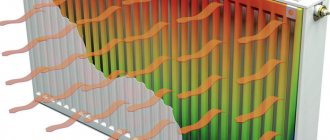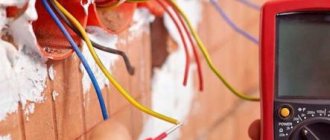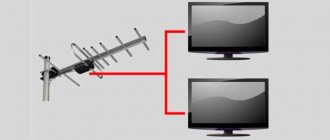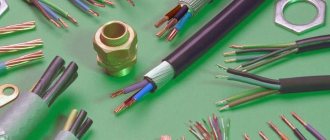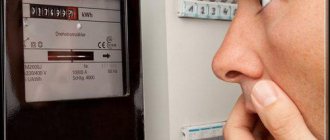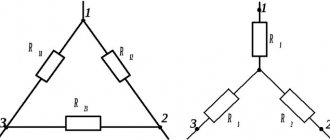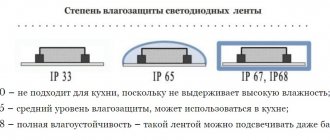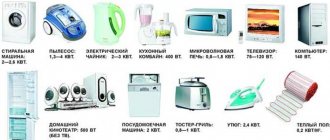How many devices can “hang” on one socket?
There are more and more useful electrical appliances in our household, yet not everyone monitors the condition of the electrical wiring in their apartments.
The number of fires caused by short circuits is increasing year by year. According to the district State Fire Supervision Service, since the beginning of the year, 33 fires have occurred in residential buildings in the North-East Administrative District for this reason. The most pressing questions regarding electrical wiring were answered by specialists from CJSC TsOPenergo, who know everything about electricity.
— What is the design load on the apartment and are there safe ways to increase it?
— In residential buildings designed and built before 2006 with gas stoves, the calculated load is 3 kW per apartment; with electric stoves - 7 kW per apartment. In residential buildings designed since the end of 2005, it has been increased - with gas stoves up to 4.5 kW per apartment; with electric stoves - 10 kW per apartment.
For luxury apartments, the load per apartment is determined by the customer.
An increase in electrical energy consumption above the standards is possible after completing design and installation work to strengthen electrical wiring in accordance with the planned commissioning of additional capacities. The reconstructed networks in the apartment must be presented to the state energy supervision authorities.
— What “improvements” pose a fire risk?
— When saturating your apartment with modern electrical appliances, first of all you need to think about whether the power of the electrical network with which the house is equipped is sufficient.
An uncontrolled increase in the power of current collectors that exceeds the permissible load on the electrical wiring, poor-quality installation of electrical equipment and wiring, non-compliance with the current standards and regulations during design and installation - all this can lead to a fire.
— How many electrical appliances can “hang” on one outlet?
— The total power of simultaneously connected devices in each outlet should not exceed the permissible load. Otherwise, the insulation may dry out prematurely and the wires may catch fire.
Each socket is designed for a specific load, usually 1 kW, that is, for one iron or kettle.
— What dangers does aluminum wiring pose?
— A continuous wire with aluminum conductors does not pose a danger, but the places where it connects to sockets, switches, and distribution boards can catch fire.
At the connection points, the wires oxidize and overheat. A conventional fuse or circuit breaker only trips when the current load is excessive, so overheating when the current is insufficient to trip the protection can cause a fire.
Over time, aluminum loses its ductility, which is why old wires break after a few bends. When moisture gets on a live wire, the metal begins to quickly deteriorate. Such properties of aluminum wiring are quite dangerous. Therefore, it is better to make new or additional wiring with copper wires, since they are of better quality and can withstand greater loads.
— Who should monitor the condition of electrical wiring in houses?
— Monitoring the condition of electrical wiring in residential buildings is entrusted to the person responsible for servicing in-house utility networks.
— Who should you trust to replace sockets and wiring in your apartment?
— If repair work is necessary, we recommend contacting an organization that services in-house networks or another organization licensed to carry out electrical installation work.
— What kind of work in the apartment can you do yourself?
— You can independently replace fuses and burnt-out lamps, turn on and off circuit breakers at the input device to the apartment, replace lighting fixtures, and clean them of dust and dirt.
print |
download for free How many devices can “hang” on one socket
, Nevsky Yu., Source: “Zvezdny Boulevard” (No. 13(90)/06), www.start-media.ru download archive.zip (6 kBt)
Total electricity power in the apartment
Each apartment or private house has a power limit that determines how many devices can be turned on simultaneously without problems. Since the kitchen is part of the home, it is impossible to devote all the power to kitchen appliances. So it is incorrect to calculate the load without paying attention to other appliances in the apartment.
In residential buildings built before 2006, the average power per apartment is about 3.5 kW for gasified houses and about 7 kW for apartments equipped with electric stoves. Since 2006, these figures have increased slightly: now they are 4.5 kW and 10 kW, respectively. By modern standards, this is, of course, not enough. In private homes the situation is better: 15 kW is standardly connected with the possibility of increasing power consumption. For an additional fee, of course.
The most accurate way to determine the power that the electrical wiring can safely withstand is from the electricity supply contract concluded with the energy supply company.
If the contract does not contain such data, then the starting point is considered to be the input circuit breaker, or rather its rated current. To determine the power, you need to multiply the current value indicated on the device by the value of the mains voltage (220 V). For example, for a 16 A machine the power will be 3.5 kW, and for a 25 A machine - 5.5 kW.
How many amperes are in a 220V outlet?
To find out how many amperes are in a regular 220V home socket, first of all, remember that current is measured in Amperes :
Current strength “ I ” is a physical quantity that is equal to the ratio of the charge “q” passing through the conductor to the time (t) during which it flowed.
The main thing that is important to us in this definition is that current strength occurs only when electricity passes through a conductor, and while nothing is connected to the outlet and the electrical circuit is broken, there is no movement of electrons, and accordingly there are no amperes in such an outlet either.
In an outlet to which there is no load connected, there are no amperes, the current strength is zero.
Now let's consider the case when some electrical appliance is connected to the outlet and we can calculate the amount of current.
If our electrical wiring were not protected by the automation installed in the electrical panel, and the maximum connected power of the equipment (as well as the current strength) were not controlled by anything, then the number of amperes in a 220V household outlet could be anything . The current would increase until the high temperature destroyed the socket mechanism or wires.
When high current flows, conductors or connections not designed for it begin to heat up and break down. As an example, we can take the spiral of an ordinary incandescent lamp, which, when an electric current passes, becomes hot, but because The tungsten from which it is made is a refractory metal; it does not collapse, which cannot be expected from the contacts of the socket mechanism.
To calculate how many amperes will be in the outlet when connecting a particular device or equipment, if you do not have an ammeter at hand, you can use the following formula:
Features of installing a group of sockets with a cable
The disadvantage of this method is that if the wire in one socket is damaged, subsequent ones will also not work. By reducing their number, the reliability of system operation increases.
According to the PUE, sockets must be connected without breaking the PE conductor. Otherwise, they remain without grounding. The group must be connected to a 16A circuit breaker with a 2.5 mm cable, and the power of the connected consumers does not exceed 3 kW. If the load is higher, a separate line is connected to each device.
It is necessary to make calculations in advance to know how many outlets can be connected in series. It is necessary to establish the type, power and number of electrical appliances. Correlate the data with the size of the room and layout. If you need a large number of outlets, it is better to lay several lines.
Formula for calculating the current in a socket
I=P/(U*cos f) , where I – Current (ampere), P – power of connected equipment (W), U – network voltage (Volts), cos f – power factor (if this indicator is not in the characteristics equipment, take 0.95)
Let's calculate using this formula how many amperes the current is in a regular home socket with a voltage (U) of 220V when connecting an iron with a power of 2000 W (2 kW) to it, the cos f of the iron is close to 1.
This means that when the iron with a power of 2 kW is turned on and heated, the current in the outlet will be about 9.1 Amperes.
When several devices are simultaneously plugged into one outlet, the current in it will be equal to the sum of the currents of this equipment.
How to increase the number of kilowatts per site?
Possibilities for increasing kilowatts can be determined by local authorities, based on the existing capacity in the area. The maximum permitted power is indicated in the technical specifications for the connection. As a rule, for a three-phase network it is 15 kW, and for a single-phase network it is 10 or 15.
How many kilowatts do you need for a comfortable stay?
The required number of kilowatts for a home is calculated based on how many electrical appliances will be installed in the house. If we take into account the presence in the house of a minimum set of electrical appliances (lighting (150 W), refrigerator (500 W), microwave (1000 W), washing machine (2000 W), TV (200 W), computer (500 W), iron (1200 W) ), vacuum cleaner (1200 W), dishwasher (2000 W)), which in total consume 8750 W when switched on simultaneously, then the available 2-4 kW of electricity will not be enough.
According to the set of rules SP 31-106-2002 “Design and construction of engineering systems of single-family residential buildings”, the load for a house is less than 60 square meters. m without electric stoves should be at least 5.5 kW, for a house with electric stoves - 8.8 kW. If the area of the house exceeds 60 sq. m, then the electricity load should be increased by 1% for each additional square meter of area. If the house uses electric heating and powerful air conditioners, 15 kW is enough.
How many electrical appliances can be plugged into one outlet?
I've searched all the forums.
I can't find an answer to a seemingly simple problem. How many electrical appliances can be powered from one outlet? We have 1) System unit 2) Monitor 3) Printer 4) Scanner 5) Subwoofer (+5 speakers) 6) Modem 7) external hard drive, video camera (sometimes connected to dump video to hard drive) 9) table lamp
And how to properly plug all this into one surge protector? I have never seen them with more than 7 nests. You have to include one filter into another. it turns out 13 nests. The design somehow looks abnormal. I've been looking at it for years now and thinking, what the hell.
The cover of an electrical outlet usually indicates the voltage and current that the outlet can handle. The maximum permissible load on the outlet should be no more than 1500 W. In addition to the current strength, the life expectancy of the socket is affected by mechanical loads and impacts on the socket. From 1000 to 1500 W, the load on the outlet can be in those apartments where there is a fuse designed for a current of 6 A. Therefore, you should not plug in electrical receivers with a current of more than 10 A into a separate outlet. This limitation is necessary due to the presence of other electrical receivers connected to the residential network. For example, a refrigerator.
and what is the essence of the question? how to connect or how many consumers?
How to properly connect 9 devices to one outlet? I'm afraid one of the above will burn out.
you need to know what cross-section of wire is in the wiring in the apartment, i.e. what load they can carry and how many amperes the protection costs in the entrance.
nothing will burn out, but the protection will simply stupidly trigger and the lights in the entire apartment will turn off or the wiring will burn out.
IMHO in apartments with a gas stove there is one outlet, in apartments with an electric stove there are two))
Calmed me down. The protection really does work all the time, especially if the kettle+microwave+vacuum cleaner+washer is installed at the same time.
If the protection is set to a higher current than the wiring is protected, then the socket may melt or a fire may occur, because The wires heat up red and light up. —-it’s better not to turn on a lot of things, especially those devices that eat a lot.
I live in Khrushchevka. The house is 40 years old. I didn't change the wiring, nor did I change the meter.
dangerously hot. in old houses they saved on wiring.
Of course it will work, these appliances are very energy-intensive, especially the kettle and microwave, IMHO don’t turn them all on at once.
I've searched all the forums. I can't find an answer to a seemingly simple problem. How many electrical appliances can be powered from one outlet? We have 1) System unit 2) Monitor 3) Printer 4) Scanner 5) Subwoofer (+5 speakers) 6) Modem 7) external hard drive, video camera (sometimes connected to dump video to hard drive) 9) table lamp
I can't find an answer to a seemingly simple problem. How many electrical appliances can be powered from one outlet? We have 1) System unit 2) Monitor 3) Printer 4) Scanner 5) Subwoofer (+5 speakers) 6) Modem 7) external hard drive, video camera (sometimes connected to dump video to hard drive) 9) table lamp
And how to properly plug all this into one surge protector? I have never seen them with more than 7 nests. You have to include one filter into another. it turns out 13 nests. The design somehow looks abnormal. I've been looking at it for years now and thinking, what the hell.
I don’t think that the listed devices can fry the socket if you don’t add electric kettles to them, especially since they have been turned on for several years. You can simplify the design: connect the monitor from the system unit - you just need another power cord. There are scanners that are powered via USB (I have one). That's a total of 7 sockets. Or don’t worry, leave it as is, put these two filters under the table and forget about it. There is another option - screw the surge protectors onto self-tapping screws from below to the tabletop, shorten the wires, fasten and parallel them. It is important that the socket itself does not have a garland of tee-adapters weighing a kilogram hanging on it - then the socket will receive a tryndets quickly and with a guarantee.
Last edited by avante22; 11/21/2009 at 12:24 pm.
Formula for calculating the current in a socket
I=P/(U*cos f) , where I – Current (ampere), P – power of connected equipment (W), U – network voltage (Volts), cos f – power factor (if this indicator is not in the characteristics equipment, take 0.95)
Let's calculate using this formula how many amperes the current is in a regular home socket with a voltage (U) of 220V when connecting an iron with a power of 2000 W (2 kW) to it, the cos f of the iron is close to 1.
This means that when the iron with a power of 2 kW is turned on and heated, the current in the outlet will be about 9.1 Amperes.
When several devices are simultaneously plugged into one outlet, the current in it will be equal to the sum of the currents of this equipment.
PUE tables
In Chapter 1 of the PUE ed. 7 (Electrical Wiring Rules) there are several tables for permissible currents across the cross-section of the wire (cable) cores. Two tables will be useful for the electrical wiring of the apartment.
Table 1.3.4 Permissible long-term current for wires and cords with rubber and PVC insulation with copper conductors.
Table 1.3.5 Permissible long-term current for wires and cords with rubber and PVC insulation with aluminum conductors.
Source
What is the maximum amperage for sockets?
Most often, modern 220V home sockets are designed for a maximum current of 10 or 16 Amperes . Some manufacturers claim that their sockets can withstand 25 Amps , but there are very few such models.
Old, Soviet sockets, which are still found in our apartments, are generally designed for only 6 Amperes.
The maximum that you can find in a standard typical apartment is a power outlet for an electric stove or hob, which can withstand current up to 32 Amperes.
These are manufacturer-guaranteed indicators of the current strength that the socket will withstand and not be destroyed. These characteristics are necessarily indicated either on the socket body or on its mechanism.
When choosing electrical installation products, keep in mind that, for example, a 16 Ampere outlet will withstand about 3.5 kilowatts of power, and a 10 Ampere outlet will only handle 2.2 Kilowatts. Below is a table of the maximum power of connected equipment for outlets, depending on the number of amperes for which they are designed.
TABLE OF MAXIMUM EQUIPMENT POWER FOR 6, 10, 16, 32 Amp Outlets
Most often, all household electrical equipment that is plugged into standard 220V sockets does not exceed 3.5 kW in power; more powerful devices have different connectors for connection or are supplied without an electrical plug, designed to be connected to terminals or to electrical plugs for power sockets .
I advise you to always choose sockets designed for a current of 16 Amps or more - they are more reliable. After all, most often electrical wiring in apartments is laid with copper cable with a core cross-section of 2.5 mm2. and place the machine on 16 Ampere sockets. Therefore, if you choose an outlet rated for 10 Amperes and connect a large load to it, the automatic protection will not work, and the outlet will begin to heat up and melt, which may cause a fire.
If you still have questions about the characteristics of sockets or their choice, be sure to write, I will try to help. In addition, any criticism, additions, opinions are welcome - write.
Table of power of household appliances for calculating the cross-section of the electrical cable
When renovating a kitchen, to calculate the cross-section of the electrical cable for the kitchen wiring, you need to understand what household appliances will be used in the kitchen. To calculate the cable cross-section, you need to know the power consumption of the household appliances used. Below are three tables, one of which is a table of the power of household appliances, averaged, but accurate enough to calculate the cross-section of the electrical cable when renovating a kitchen.
Two other tables allow you to calculate the cross-section of the cable cores needed to power these devices based on the total power of household appliances.
Table 1: Power consumption/Current strength/Cable cross section (wire)
| Power, W | Current strength, A | Wire cross-section, sq.mm |
| 200 | 0,9 | 0,1 |
| 400 | 1,8 | 0,2 |
| 800 | 3,6 | 0,4 |
| 1 000 | 4,5 | 0,5 |
| 1 500 | 6,8 | 0,7 |
| 2 000 | 9,1 | 0,9 |
| 2 500 | 11,4 | 1,1 |
| 3 000 | 13,6 | 1,4 |
| 3 500 | 15,9 | 1,6 |
| 4 000 | 18,2 | 1,8 |
| 5 000 | 22,7 | 2,3 |
| 6 000 | 27,3 | 2,7 |
| 7 000 | 31,8 | 3,2 |
| 10 000 | 45,5 | 4,5 |
Table 2: Power of household appliances according to the passport
| Electrical appliances in the kitchen (comparison table) Electrical appliances | power, kWt | Duration of operation during the day |
| Toaster | 0,8 | 10 min |
| Coffee maker: | 0,8 | |
| brewing coffee | 12 min | |
| keeping hot | 3 hours | |
| Dishwasher | 2 | 2 loads daily, 24 min per wash cycle |
| deep fryer | 1,5 | 17 min |
| Kettle | 2 | 10 min |
| Oven | 2 | 2 hours |
| Plate: | 8 | |
| large heating element | 1 hour | |
| small heating element | 1 hour | |
| Fridge | 0.2 (compressor + lamp) | 7 h (including shutdown time using relay) |
| Freezer | 0.2 (compressor + lamp) | 7 h (including shutdown time using relay) |
| Microwave | 0,85 | 10 min |
| Microwave oven combination | 2,65 | 30 min |
| Roaster | 1,5 | 30 min |
| Instantaneous water heater | 2 | 30 min |
| Washing machine | 3 | 1.5 h |
| Clothes dryer | 3 | 30 min |
| Food processor | 0,4 | 15 minutes |
| Hood (ventilation) | 0,3 | 30 min |
Table 3: Power of household appliances and lighting
| Spotlight (halogen lamps) |
| Independent hob |
| ZANUSSI-4 simple+2 inductor burners |
| Built-in kit HANSA |
| Burners(2.2+1.2+1.2+1.8) kW |
| TOTAL MAX. POWER |
| GRILLS, BBQ GRILLS, BBQ GRILLS |
| Microwave ovens without grill |
| Microwave ovens with grill |
| Energy class "A" |
Calculation of cable core cross-section
Calculation of the cross-section of cable cores for electrical wiring depending on power consumption. Using this table, you can calculate what cross-section of cable cores you need to use, depending on the total power of household appliances connected to this cable.
For example. The total power of the group of household appliances according to tables 2 and 3 was 6600 W. Power supply 220 Volt. Looking at the table, we see that this group requires a cable with copper conductors with a cross-section of 2.5 mm. A current of 30 Amps shows that to protect this group you need a circuit breaker with a cut-off current of at least 30 Amps. This means that we buy a circuit breaker with a rating of 32 Amps.
| Laid open | ||||||
| S | Copper conductors | Aluminum conductors | ||||
| mm2 | Current | Power kW | Current | Power kW | ||
| A | 220 V | 380 V | A | 220 V | 380 V | |
| 0,5 | 11 | 2,4 | ||||
| 0,75 | 15 | 3,3 | ||||
| 1 | 17 | 3,7 | 6,4 | |||
| 1,5 | 23 | 5 | 8,7 | |||
| 2 | 26 | 5,7 | 9,8 | 21 | 4,6 | 7,9 |
| 2,5 | 30 | 6,6 | 11 | 24 | 5,2 | 9,1 |
| 4 | 41 | 9 | 15 | 32 | 7 | 12 |
| 5 | 50 | 11 | 19 | 39 | 8,5 | 14 |
| 10 | 80 | 17 | 30 | 60 | 13 | 22 |
| 16 | 100 | 22 | 38 | 75 | 16 | 28 |
| 25 | 140 | 30 | 53 | 105 | 23 | 39 |
| 35 | 170 | 37 | 64 | 130 | 28 | 49 |
| Installed in a pipe | ||||||
| S | Copper conductors | Aluminum conductors | ||||
| mm2 | Current | Power kW | Current | Power kW | ||
| A | 220 V | 380 V | A | 220 V | 380 V | |
| 0,5 | ||||||
| 0,75 | ||||||
| 1 | 14 | 3 | 5,3 | |||
| 1,5 | 15 | 3,3 | 5,7 | |||
| 2 | 19 | 4,1 | 7,2 | 14 | 3 | 5,3 |
| 2,5 | 21 | 4,6 | 7,9 | 16 | 3,5 | 6 |
| 4 | 27 | 5,9 | 10 | 21 | 4,6 | 7,9 |
| 5 | 34 | 7,4 | 12 | 26 | 5,7 | 9,8 |
| 10 | 50 | 11 | 19 | 38 | 8,3 | 14 |
| 16 | 80 | 17 | 30 | 55 | 12 | 20 |
| 25 | 100 | 22 | 38 | 65 | 14 | 24 |
| 35 | 135 | 29 | 51 | 75 | 16 | 28 |
PUE tables
In Chapter 1 of the PUE ed. 7 (Electrical Wiring Rules) there are several tables for permissible currents across the cross-section of the wire (cable) cores. Two tables will be useful for the electrical wiring of the apartment.
Table 1.3.4 Permissible long-term current for wires and cords with rubber and PVC insulation with copper conductors.
Table 1.3.5 Permissible long-term current for wires and cords with rubber and PVC insulation with aluminum conductors.
©Remont-kuxni.ru
Other articles in the section: Kitchen electrics
Table of power of household appliances for calculating the cross-section of the electrical cable
- Planning a kitchen renovation - stages of a kitchen renovation
Source: https://remont-kuxni.ru/2011/07/tablitsa-moshhnostey-byitovyih-priborov-dlya-rascheta-secheniya-elektrokabelya.html
How to reliably and safely connect an outlet to a household network
How do you feel about tees and doubles used in household wiring? I guess it's ambiguous. They allow you to operate a larger number of electrical appliances than the number of sockets allows. But they should be used carefully.
This is what will be discussed below. I hope that my advice from an electrician will help you, as a home handyman, when renovating an apartment with your own hands, correctly connect sockets to your home wiring, use them reliably and as safely as possible.
The idea to talk about this arose after a comment appeared from a Mmoguider reader on an article talking about the height of placement of sockets and switches in an apartment. I answered him briefly there, but now I’m trying to explain in more detail.
The concept of permissible electrical power for an apartment and ways to increase it
Based on para. 7 clause 2 of Rule No. 861, the maximum installed electrical power is the largest amount of power that can be allocated by the electricity provider. It is measured in kilowatts, taken into account by common house and apartment appliances, and paid according to the established tariff. But in some cases, the power is not enough, and consumers begin to think about increasing it through legal means.
- What is “dedicated power” of electricity?
- What are the dangers of exceeding the permitted power?
- Rules and regulations
- How to find out how much power is allocated
- Calculation of required power
- How many kilowatts can the wiring in the apartment withstand?
- How to increase allocated power
- For individuals
- For legal entities and companies
What power is the socket designed for?
When choosing a socket mechanism, pay attention to the rated current at which it can be used for a long time. Its size is marked on the back of the case.
This value must not be exceeded. Otherwise, a regime will arise when the temperature heating from the passing current begins to significantly exceed the ability of the structure to remove heat to the environment. This will lead to contact burnout and may cause a fire.
Let's imagine that a tee with a connected TV, a landline phone power supply and a mobile phone charger is connected to a 6 ampere outlet, as shown in the very first photo, or a more powerful iron with 1000 watts of power.
Through the socket and the plug or tee inserted into it, load current will flow to all connected consumers.
Right on the picture is the working load calculation which will be 4.5A which is less than the rated value. This means that we have a power reserve, and the outlet is not overloaded.
However, if you power a washing vacuum cleaner with a consumption of 2000 watts from it, then the current will be 2000/220 = 9 amperes. This value is more than the socket can withstand and its mechanism will burn out.
Methods for upgrading an outlet
There are two ways to install several sockets in place of one, which are often used in everyday life:
- installation of a double socket;
- installation of a block of several sockets.
The methods are not equivalent, so to make the right choice you need to know the features of the devices used.
Advantages of a double socket:
- the ability to select a model suitable for installation in an existing socket box - without causing damage to the finishing of the apartment by installing an additional mounting socket;
- lower cost than two single ones.
How to choose electrical wiring
Let us pay attention to this issue because current-carrying conductors must reliably transmit the electrical power applied to them, creating heating of the metal and its insulation no higher than the permissible temperature. Otherwise, the dielectric layer will be damaged and leakage currents will flow through it.
Then the potential of the phase can at any time appear on the housing of household appliances or metal building elements, which will lead to electrical injuries to residents. The only way to prevent them is to use an RCD. And if it is not there, as usually happens, then trouble is guaranteed.
We remind you that in places where wires are poorly connected and electrical contacts are broken, the temperature increases abruptly. It can cause a fire.
Wires in old buildings
The principle of providing the population with electricity in Soviet times was solved through the creation of several standard projects for laying wiring in apartments. At that time, this was the best option for solving the problems of state building.
The wires, taking into account the low loads by today's standards, were made of 2.5 sq mm aluminum wire. There was a 5 amp meter at the entrance to the apartment, and there were two outlets in each room. Their power reserve was sufficient.
Now the power of household appliances, and their number in each family, has increased sharply. But people still live with old wiring and use tees and extension cords, which can lead to dire consequences.
Modern loads can create emergency situations in old aluminum wiring, which is rated for a maximum of 20 amperes.
Modern wiring
Aluminum wires and cables for installation in residential premises are already prohibited by current rules. In old buildings, some residents replace them with their own hands, while others continue to exploit them, hoping for a Russian “maybe.”
To connect sockets, use only copper wires and cables with a core cross-section of 6, 4 or 2.5 sq. mm. It should be taken into account that they can withstand a current averaged for different operating conditions of 27 A for 2.5 square meters, 38 for 4 and 46 amperes for 6 mm square. There is no point in considering large loads.
Loads of public buildings
6.13 Demand factor
to calculate the loads of working lighting
of the supply network
and inputs of public buildings should be
taken according to table 6.5
.
6.14 Demand factor
to calculate
the group network
of working lighting, distribution and group networks of evacuation and emergency lighting of buildings, shop window lighting and illuminated advertising should
be taken equal to 1
.
6.15 The demand factor for calculating the electrical loads of the lines supplying stage lighting in halls, clubs and cultural centers should be taken equal to 0.35 for adjustable stage lighting and 0.2 for unregulated lighting.
6.16 Estimated electrical load of lines supplying sockets P
р.р kW, should be determined by the formula
where K
с.р - calculated demand coefficient, adopted according to table 6.6;
R
u.r -
installed power of the socket
, accepted 0.06 kW (including for connecting office equipment);
n
— number of sockets.
Organizations, enterprises and institutions
TO
c.o depending on the installed power of working lighting, kW
Hotels, dormitories and administrative premises of sanatoriums, holiday homes, boarding houses, tourist centers, health camps
Catering enterprises, nurseries, educational and production workshops of vocational schools
Organizations and management institutions, financing, lending and state insurance institutions, secondary schools, special educational institutions, educational buildings of vocational schools, consumer services, trade, hairdressing salons
Design and engineering organizations, research institutes
Assembly halls, conference rooms (hall and presidium lighting), gyms
Clubs and houses of culture
NOTE The demand factor for installed task lighting power not listed in the table is determined by interpolation.
Organizations, enterprises and institutions
Management organizations and institutions, design and engineering organizations, research institutes, financing, lending and state insurance institutions, secondary schools, special educational institutions, educational buildings of vocational schools
Hotels 1, dining rooms of restaurants, cafes and canteens, consumer service enterprises, libraries, archives
1 In the absence of stationary general lighting in the living rooms of hotels, the calculation of the electrical load of the socket network intended to power portable lamps (for example, floor lamps) should be carried out in accordance with the requirements of 6.13 and 6.14 of this Code of Rules.
6.17 With mixed power supply of general lighting and socket network, the calculated load P
p.o, kW, should be determined by the formula
where P'
p.o - design load of general lighting lines, kW;
R
r.r - design load of the outlet network, kW.
6.18 Estimated load of power supply lines and inputs P
r.s, kW, should be determined by the formula
where K
c is the estimated demand coefficient;
R
u.s - installed power of electrical receivers (except for fire-fighting and backup devices), kW.
6.19 Demand factors
to calculate the load of inputs, supply and distribution lines
of power electrical networks
of public buildings should be
determined according to table 6.7.
Lines to power electrical receivers
TO
c is taken with the number of working electrical receivers
Technological equipment of public catering establishments, catering units in public buildings
According to table 6.8 and according to clause 6.21
According to table 6.8 and according to clause 6.21
Mechanical equipment for public catering establishments, catering units of public buildings for other purposes, trade enterprises
According to pos. 1 table 6.9
According to pos. 1 table 6.9
Buildings (premises) of management, design and engineering organizations (without catering units), hotels (without restaurants), food and manufactured goods stores, secondary schools, special educational institutions and vocational schools (without catering units)
Plumbing and refrigeration equipment, refrigeration units, air conditioning systems
According to pos. 1 table 6.9
According to pos. 1 table 6.9
Passenger and freight elevators, conveyors
According to clause 6.7 and table 6.4
According to clause 6.7 and table 6.4
Electric drives for stage mechanisms
Computers (without technological conditioning)
Technological conditioning of computers
According to pos. 1 table 6.9
According to pos. 1 table 6.9
Metalworking and woodworking machines in workshops
Copying equipment, photo laboratories
Laboratory and educational equipment for secondary schools, vocational schools, secondary specialized educational institutions
Training and production workshops of vocational schools, secondary schools and special educational institutions
Technological equipment for hairdressing salons, ateliers, workshops, consumer service plants, trade enterprises, medical offices
Technological equipment for dry cleaning and laundries factories
Hand and heated towel rails
1 The design load must be no less than the power of the largest electrical receiver.
2 The demand coefficient for one power receiver should be taken equal to 1.
6.20 Design load
supply lines
of technological equipment
and dishwashers of public catering establishments and catering units
P
r.s., kW, should be determined by the formula
where P
r.p.m - design load of dishwashers, kW, determined taking into account the demand coefficient, which is accepted according to table 6.10;
R
р.т — design load of process equipment, kW, determined taking into account the demand coefficient, which is accepted according to table 6.8.
6.21 Total
the design
load
of supply lines and power inputs
of public catering enterprises P
r.s., kW, should be determined by the formula
where P
r.s.t - design load of plumbing equipment lines or refrigeration machines, determined with the demand coefficient, which is taken according to position 1 of table 6.9 and note 2 to table 6.8.
The design load of power inputs of public catering establishments at enterprises, organizations and institutions intended to serve persons permanently working in the institution, as well as at educational institutions, should be determined by formula (11) with a coefficient of 0.7.
Number of electrical receivers of thermal equipment of public catering establishments and catering units connected to this network element
TO
s for process equipment
1 To technological equipment
should include: thermal (electric stoves, food warmers, frying pans, frying and pastry cabinets, boilers, boilers, deep fryers, etc.); mechanical (dough mixing machines, universal drives, bread slicers, vibrating sieves, cocktail beaters, meat grinders, potato peelers, vegetable cutting machines, etc.); small refrigeration (refrigeration cabinets, household refrigerators, low-temperature counters and similar devices with a unit power of less than 1 kW); elevators, lifts and other equipment (cash registers, radio equipment, etc.).
How automatic protections ensure electrical safety
We have analyzed the normal power modes of household appliances according to the loads they create on wiring and sockets. These currents must be reliably transmitted from the power source to the consumer.
Now let’s assume that a water hose bursts inside the washing machine, and the phase and zero potentials are closed in the wet area. Or, for example, an inexperienced home craftsman drilled into a live cable.
In both cases, a short circuit current will immediately occur, which is accompanied by an electric arc. Its power not only burns the insulation, but also melts the wiring, spraying the liquid copper metal with sparks in all directions.
To prevent the development of a fire, circuit breakers are used, which completely remove the voltage from the equipment they protect in a split second. They must be selected correctly based on many parameters.
This issue is presented in a separate article about the design of the circuit breaker and the principles of its operation. We recommend you read it. Pay special attention to checking the phase-zero loop. Few people still do it. And this is very important.
How socket connection methods affect the home network load
The technology for laying electrical wires inside an apartment can be done using various methods. This topic is described in detail in the article about wiring diagrams for power sockets. Check it out.
One method of maintaining the design of a room with old wiring is to use outlet blocks as shown in the photo.
Just do not forget that it is necessary to constantly monitor the load connected to it and not allow it to exceed the ratings of the socket mechanism, the wires involved and the circuit breakers.
The safest way to connect sockets is radial, powered by individual circuit breakers. Since it is the most expensive, and the loop method is risky, it is optimal to switch sockets in a mixed way with control of the flowing loads.
It's time to sum it up: connecting the outlet to the household network must be reliable and safe. The home master, when performing this work, must maintain a balance between:
- working loads;
- switching abilities of socket mechanisms;
- technical capabilities of household wiring;
- established protections.
Pay attention to all 4 points. And now we recommend watching the video from the owner of RozetkaOnline “How to connect an outlet.”
If you still have questions about this topic, ask in the comments. Just in case, we remind you that it is now convenient for you to share the material you read with your friends on social networks.
